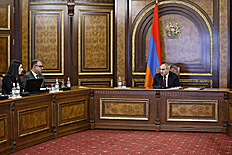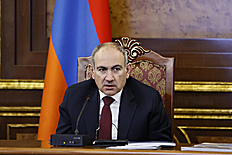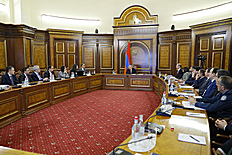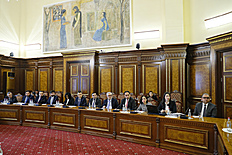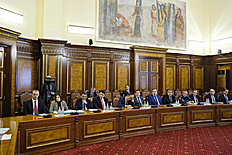Press releases
The implementation process of the Disaster Risk Management Strategy for 2023-2030 discussed at Government
more 3 photos
A consultation was held under the chairmanship of Prime Minister Nikol Pashinyan, during which the implementation process of the Action Plan of the Disaster Risk Management Strategy for 2023-2030 was discussed.
The strategy includes 46 measures. It was reported that during the reporting period, work was carried out to improve the functional and methodological foundations of the disaster risk management (DRM) system, including the improvement of DRM legislation at the national level, the formation of a disaster risk assessment and indexing system, the development of a framework for post-disaster needs assessment and recovery processes, the inclusion of DRM requirements in the field of urban development, and the increase in the effectiveness of DRM processes at the local level in the field of climate change adaptation and biological hazards. Work was carried out to introduce DRM plans and increase capacity in communities, educational institutions and health institutions, and the inclusion of DRM components in strategic programs for the development of the tourism sector.
In order to continuously improve the ARK technology-based system, work has been carried out to develop climate change adaptation capabilities, strengthen mudflow risk management capabilities, and increase the level of disaster resistance of cities based on the geographic information system. New specialties (educational programs) have been introduced at the “State Academy of Crisis Management” SNCO of the Ministry of Internal Affairs. Seismic risk assessment has been carried out in the urban settlements of Agarak and Meghri.
Within the framework of actions aimed at human capital development, at least one rescue-volunteer squad has been created in Yerevan and each region. During 2024, 9 volunteer fire-rescue squads launched their activities in the regions of the Republic of Armenia.
In order to strengthen the culture of safety, public awareness of the DRM sector has been raised by introducing DRM educational component into educational programs.
Among the key achievements of 2024, the definition of institutional mechanisms, awareness raising and logistical readiness were highlighted.
Brief information was provided on the work carried out after the floods in Lori and Tavush regions.
It was noted that according to new experience, the following works are planned: increasing the number of community rescue-volunteer teams and developing their capabilities, improving interdepartmental cooperation and crisis communication processes in the field of DRM, continuous improvement of the capabilities of the Rescue Service, including educational, development of the logistical base, modernization and improvement of the early warning system, development of the hydrometeorological system, widening of river beds, regular cleaning of garbage, restoration and construction of retaining walls and coastal protection structures, development of a disaster risk indexing system.
Prime Minister Pashinyan emphasized the importance of developing capacities in communities to combat disasters, as well as conducting an audit of existing disaster risk management plans, comparing them with the actions actually taken in the event of a disaster. Nikol Pashinyan noted that as a result, gaps in already developed plans should be identified and appropriate changes should be made to them. In the context of disaster management, the Prime Minister also emphasized the need to define early warning standards and mapping existing infrastructure.
